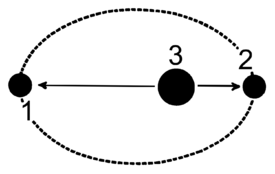Tags | |
UUID | 6b1a7f36-580e-11e6-9770-bc764e2038f2 |
The Apsis-Apocenter Minimum Speed calculator computes the minimum speed in an orbit at apogee based on the semi-major axis (a), eccentricity (e), the mass of the primary body (M), and the Universal Gravitational Constant (G).
INSTRUCTION: Choose units and enter the following:
- (M) This is the mass of the primary body.
- (a) This is the semi-major axis of the orbit
- (e) This is the eccentricity of the the orbit
Maximum Orbital Speed(Vap): The calculator returns the velocity in meters per second. However this can be automatically converted to compatible units via the pull-down menu.
The apsides indicate the nearest
and furthest points of an
orbiting body around its host.
(1) farthest - apocenter
(2) nearest - pericenter
(3) focus - primary
Related Calculators
- Force of Gravity computes the force of gravity between two bodies.
- Apsis-Apocenter (minimum speed) computes the minimum velocity at the maximum distance of an orbit.
- Apsis-Apocenter (maximum distance) computes the greatest distance from the center of gravity in an orbit.
- Apsis-Pericenter (maximum speed) computes maximum velocity at the minimum distance of an orbit.
- Apsis-Pericenter (minimum distance) computes the minimum distance from the center of mass in an orbit.
- Standard Gravitational Parameter
The Math / Science
The Apsis-Apocenter is an extreme point in an object's orbit. For elliptical orbits about a larger body, there are two apsides. This is commonly known as the apogee. The apocenter is the point furthest away from the object being orbited.
The formula for the Apsis-Apocenter minimum speed is:
where:
- vap is velocity at apogee
- e = eccentricity
- a = semi-major axis
- μ = standard gravitational parameter (μ = M•G)
References
Wikipedia (https://en.wikipedia.org/wiki/Apsis)
Equations and Data Items
Calculators
- Comments
- Attachments
- Stats
No comments |
